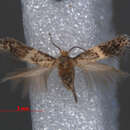Ectoedemia hendrikseni: Brief Summary
provided by wikipedia EN
Ectoedemia hendrikseni is a moth of the family Nepticulidae. It is only known from a small area in the Provence region in southern France (the Estérel Massif in the Alpes-Maritimes and Var).
The wingspan is 6-6.8 mm. Adults are on wing from May to June. An individual record in October may represent a (partial) second generation or a late emerging specimen.
The larvae have been reared on Quercus suber. They mine the leaves of their host plant. The mine consists of a narrow, partly contorted gallery in the first half changes suddenly in a large blotch mine with two lateral bands of frass.

Male genitalia

Male genitalia

Female genitalia

Female genitalia

Female terminal abdominal segment

Leafmine
- license
- cc-by-sa-3.0
- copyright
- Wikipedia authors and editors
Description
provided by Zookeys
Description. Male (Figs 35–36). Forewing length 2.6–3.0 mm, wingspan 6.0–6.8 mm. Head: frontal tuft ochreous, collar greyish; scape yellowish white; antenna with 36–40 segments, brown-grey. Thorax and forewings fuscous black, thorax with some grey scales anteriorly and on metathorax, metallic shiny. Forewing: basal half covered with coarse black scales, medial fascia sharp, ochreous, narrowed towards costa; distal to fascia are individual coarse scales distinct, sometimes with ochreous ground colouration between them, especially on edge; cilia-line interrupted; cilia ochreous grey; underside grey. Hindwing: grey, with brown hair pencil near frenulum, surrounded by white androconial scales in basal half, partly brown towards base; cilia grey; underside ochreous grey. Abdomen and legs ochreous brown-grey.
Female. Forewing length 2.8–3.0 mm, wingspan 6.3–6.6 mm. Antenna with 29–34 segments. The coloration as in male, hindwing grey, without androconial scales.
Male genitalia (Figs 45, 49). Vinculum distinctly concave anteriorly. Tegumen with a bulbous, rounded pseuduncus, with several long setae. Gnathos broad, its processes and connecting bar of equal breadth, lateral processes rounded at their ends, only slightly shorter than central element. Valva broad, with an angular inner lobe on its base and with only slightly elongate distal process, sublateral processes about ¼ transtilla length. Aedeagus with distinct cathrema, with numerous very small cornuti in vesica, carinae simple, slightly curved, not pointed.
Female genitalia (Figs 54, 58, 62). T7 on either side with a patch of ca 35 long setae along margin with T8; T8 on disc with ca 40 long setae on either side; T8 with rounded corners, slightly indented posteriorly. Papillae anales broadly rounded, with many short setae, approximately 80–90 on each. Apophyses short and thick. Vestibulum with distinct vaginal sclerite and a spiculate pouch with small spines arranged as pectinations. Corpus bursae ca. 790μm long, almost globular, covered with minute pectinations; signa dissimilar, resp. ca 415 and 610 μm long (n=1), approximately 2.1–2.9 as long as wide. Ductus spermathecae with about 5.5 narrow sclerotized convolutions.
- bibliographic citation
- Van Nieukerken EJ, Laštůvka A, Laštůvka Z (2010) Western Palaearctic Ectoedemia (Zimmermannia) Hering and Ectoedemia Busck s. str. (Lepidoptera: Nepticulidae): five new species and new data on distribution, hostplants and recognition.
Distribution
provided by Zookeys
Distribution. Known from a small area in the Provence region in Southern France: the Estérel massif in the Alpes Maritimes and Var.







